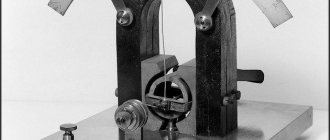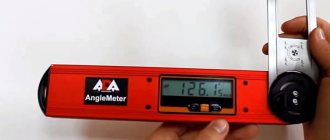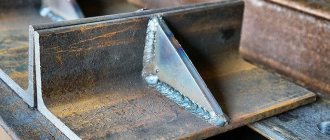Micrometer design
Manufacturers offer a couple of designs of this type, which perform certain actions and are an improved model. The most common micrometer design looks like this.
The first thing you should pay attention to when considering this unit is the metal bracket, which is made in one size and does not change its parameters.
- This part is equipped with a metal heel at one end and a screw at the other.
- It is designed in such a way that the distance parameters between them are displayed on the digital scale of the device.
- If you secure the screw before measuring the part, you can get its exact diameter. Which will be displayed on the scale.
- The peculiarity of the unit is that it is a contact version. Those. compresses the measuring material tightly enough. Therefore, it is not suitable for soft fabrics.
To prevent the system from malfunctioning, the device is equipped with a lock. It is made in such a way that if you come into contact with it, you can avoid any damage to the micrometer, from unscrewing the screws to shifting the measurement parameters. Therefore, the unit shows the most accurate value, down to the millimeter.
External links [edit]
- Dictionary definition of micrometer in Wiktionary
| vteMetric units of length | |
| From smallest to largest (from left to right). Commonly used units are shown in bold italic . | |
| |
Where is a micrometer used?
The device is needed in many industries. But it gained great popularity when used by the following specialists:
- Turners and foundry workers;
- Milling workers;
- Laboratory specialists;
- Masters of jewelry activities;
- Modelers.
For the above activities, a micrometer simply cannot be replaced. It is with its help that you can get the exact value. Even a caliper can't handle it.
Symbol [edit]
See also: Micro- § Character encoding in character sets
Official symbol for the prefix SI micro-
- Greek small letter mu. [11] Unicode also has a microcharacter with code point U+00B5 (µ), distinct from the U+03BC (µ) code point of the lowercase Greek letter mu. According to the Unicode Consortium, the Greek letter character is preferred [12], but implementations should also recognize the microcharacter. Most fonts use the same glyph for two characters.
Types of micrometers
This device is practically not used for home use. But it is actively used for other areas of activity. It is represented by more than 20 types on the measuring equipment market.
Each of which has its own measurement specifics and is used by certain specialists. Among them there are also rare units, special in that they are used in certain activities.
And there are also very popular micrometers such as:
- Sleek device. The most widespread and purchased among its analogues. Used for taking measurements from external parts and workpieces. They are not intended to measure the external size of elements;
- Sheet device. Manufactured with plates on the screw part. Thanks to these parts, the unit fits tightly to the object being measured, showing its exact size. In demand in blacksmithing and workshops specializing in the smelting of metal sheets;
- A device for measuring hot webs. It is used in the production of metal products. The advantage is taking measurements from hot metal. Thanks to this unit, it is possible to stop the smelting of any product in time;
- Device for deep measurement. Equipped with an extended bracket, which can measure parts using the throw method. Ideal for removing thickness from elements that have blind drilling and countersinking;
- Pipe devices. Designed for measuring pipes. This unit does not particularly stand out among others, but displays the exact value when it comes into contact with the walls of the product. The unit is made in the form of a cut-off bracket, which has a cut-off bracket at its end. This detail helps to take measurements even from the thinnest fabric;
- Wire device. It has a compact size. The micrometer has the same parameters as pliers. It is convenient to carry and take with you anywhere. Designed for measuring wire and twigs. The appearance of the tool is quite simple - a metal rod without a bracket. But this is quite enough to take accurate measurements, which are helped by the small range of motion in the device;
- Device with small jaws. It somewhat resembles a smooth micrometer. But it differs in the thin alloy of the heel and screw. This makes it suitable for taking measurements from thin fabric, as well as for measuring machined or drilled surfaces;
- Universal device. Suitable for measuring almost all elements. The micrometer is equipped with removable tips and is produced in two price categories. This is an expensive and cheap model. The first option is characterized by high-quality fastening of the tips, which gives an advantage in accurate measurements. The cheap device is also equipped with tips, which are distinguished by the presence of a gap between them and the measured element. Which affects the error of the device, so you should not expect an exact value from such a unit. But for the home, an inexpensive device is quite useful;
- Grooving device. Designed for measuring workpieces in hard-to-reach places. Equipped with plates, which are also called sponges. You need to work with the unit carefully, since the plates can become deformed under strong compression or become unusable if the device is accidentally dropped. Outwardly, it resembles a wire instrument, differing from it in the absence of a bracket;
Digital device. Has many varieties. From a simple electronic device to an advanced device equipped with built-in memory and functionality. Battery operated.
It does not serve as much as a mechanical unit, and does not differ in measurement accuracy. But it is convenient for work in production when measuring workpieces. Especially if the deadline for submitting the work is reduced to a minimum.
Notes and links[edit]
- ^ abc "micrometer". Encyclopedia Britannica Online
. Retrieved May 18, 2014. - "Wool fiber". New South Wales Department of Education and Communities
. Archived from the original (download Word document) on June 17, 2016. Retrieved May 18, 2014. - Smith, D. J.; Gaffney, E. A.; Blake, Jr.; Kirkman-Brown, J. C. (25 February 2009). "Accumulation of human sperm near surfaces: a simulation study" (PDF). Journal of Fluid Mechanics
.
Cambridge University Press. 621
: 295. Bibcode: 2009JFM ... 621..289S. DOI: 10.1017/S0022112008004953. Archived from the original (PDF) on November 6, 2013. - Ramel, Gordon. "Spider Silk". Archived from the original on December 4, 2008. Retrieved December 14, 2008. A typical strand of garden spider silk has a diameter of about 0.003 mm... Dragline silk (about 0.008 mm in Nephil
) - "Fibreshape Applications". LLC "IST - Innovative sintering technologies". Retrieved December 4, 2008. Fiber thickness histogram [micrometer]
- The diameter of human hair ranges from 17 to 181 microns. Ley, Brian (1999). Ehlert, Glenn (ed.). "The diameter of a human hair". Collection of facts on physics
. Retrieved December 8, 2022. - IBA - Resolution 7 of 13 Civil Code 1967/68), “Cancellation of previously adopted decisions (micron, new spark plug).”
- Proceedings of the Royal Society of Queensland. Part I. XIX
. H. Pole and Co. 1907 - via Google Books. - Bigalow, Edward Fuller; Agassiz Association (1905). Observer. 7–8
- via Google Books. - 10 micron / 10 micron (started in 1885; before that, the word "micron" in singular or plural was rarely used)
- "Prefixes of the International System of Units". International Bureau of Weights and Measures. Retrieved May 9, 2016.
- Beaton, Barbara; Freytag, Asmus; Sargent, Murray III (30 May 2017). "Unicode® Technical Report No. 25". Unicode Technical Reports
. Unicode Consortium. clause 11.
How to choose a micrometer
Micrometers are used mainly in production, but there are options for home use. A beginner may be wondering how to choose the right device. Everything is simple here.
A micrometer with an accuracy of up to 50 microns is quite suitable for home use. It has an inexpensive price and can cope with any task in everyday life.
For production work, it is worth choosing devices of pointer, manual and desktop-mechanical versions. The main feature of such units is accurate measurement. After all, all production activities depend on this.
For jewelry work, when creating electronics and in laboratory work, the most accurate and high-quality micrometers are needed. Only they can show the value without the slightest error.
Examples[edit]
How big is 1 micrometer?
From 1 µm to 10 µm:
- 1–10 µm is the length of a typical bacterium
- 10 microns - the size of fungal hyphae
- 5 µm is the length of a typical human sperm head [3]
- 3–8 µm – width of the spider web silk thread [4]
- about 10 microns - the size of a fog, mist, or cloudy water droplet
For more examples of sizes from 1 to 10 micrometers, see § 1 micrometer Orders of magnitude (length).
From 10 µm to 100 µm:
- about 10–12 microns - thickness of polyethylene film (food film)
- From 10 to 55 microns - the width of the wool fiber [5]
- From 17 to 181 microns - the diameter of a human hair [6]
- From 70 to 180 microns - paper thickness
For more examples of sizes from 10 to 100 micrometers, see § 10 micrometers Orders of magnitude (length).
Rating of the best micrometers (TOP 5 manufacturers)
Based on reviews from ordinary customers and specialists, a list of the best devices was compiled:
- FIT 19909;
- Bison “Expert”;
- MCC 25 GRIFF;
- Sheet micrometer ML-25;
- ASIMETO 152-01-0.
Determination of instrument readings
The pointer when counting on scale 2 of the stem is the end of the drum, and the longitudinal stroke 1 is the pointer for the circular scale 3. The numbered scale of the stem shows the number of millimeters, and its additional scale serves to count half millimeters.
Let us mark the last stroke of the millimeter scale of the stem, completely opened by the drum. Its value is an integer number of millimeters and is indicated in green in the figure. If there is an open line of an additional scale to the right of this stroke (highlighted in blue), you need to add 0.5 mm to the resulting value.
When reading the readings of the circular scale 3, take into account its value that coincides with the longitudinal stroke 1. Thus, in the upper image, the readings of the device are:
- 16 + 0.22 = 16.22 mm.
- 17 + 0.5 + 0.25 = 17.75 mm.
A common mistake is when the value of 0.5 mm is incorrectly taken into account (or not taken into account). This is due to the fact that the stroke of the additional scale closest to the drum may be partially open. If necessary, check yourself with a caliper.
Photo of micrometers
Where to start choosing a cartridge?
1. Dimensions of your cartridge.
Usually they are indicated in the instructions for the filter, or directly on its body. There are three main types of cartridges based on size:
If you have a non-standard size cartridge, contact a special company. Such cartridges are usually used only on filters from certain manufacturers.
2.Contamination of your water.
For example, if there is iron in the water, then you need a cartridge to purify the water from iron. In order to get water with a good taste and remove chemical elements, you need a water softening cartridge. It is worth knowing that at the final stage of cleaning you need to use a cartridge with bactericidal additives.
If you bought a water filter, then most likely you heard the word “micron”. A micron is a unit of measurement equal to 0.001 millimeters. The following types of cartridges are distinguished: 1 micron (µm), 5 microns (µm), 10 microns (µm), 20 microns (µm), 50 microns (µm), 100 microns (µm).
3.Number of cleaning stages.
The number of cleaning stages can be up to four, and sometimes even five. Here is an approximate order of arrangement of cartridges: mechanical cleaning (polypropylene) => Water softening => removal of some salts, iron (carbon) => enrichment with minerals => post-filter (installed in reverse osmosis systems to eliminate unpleasant taste and odor).
4.Method of cleaning the cartridge
Based on the cleaning method, cartridges are divided into the following types:
Polypropylene. Such cartridges are made of foamed polypropylene. They purify water from various contaminants, sand and rust. Typically used for pre-purification of water. Polypropylene cartridges need to be changed approximately every 3-4 months.
Thread. These cartridges are made of thread (polypropylene), it is wound on a rigid core. Just like polypropylene, they are used for preliminary water purification. They need to be replaced every 3 months.
Coal. The basis of which the cartridge consists is activated carbon. Such cartridges clean water from dirt and chlorine. And the smell and taste of water becomes more pleasant. Carbon cartridges are replaced once every six months.
Sorptive. Designed to purify water from chlorine and various contaminants. Since they often contain silver, they have a bactericidal effect. The cartridges also contain carbon.
Iron removal. Used to purify water from iron and hydrogen sulfide.
Membrane. They clean the liquid from many contaminants and even viruses. Such cartridges should be changed once a year.
In conclusion, I would like to note that the choice of a water filter cartridge depends only on you and your needs. Pay attention to the smell, taste and color; for a more reliable result, you can do a water analysis.
After you have done a water analysis in the laboratory, buy a filter and, accordingly, a cleaning cartridge that you need.
We write about the life of our company, about new products, and give advice. Subscribe to our newsletter
Thank you for subscribing to us!
Source
Options for selecting in-line filters
To clean tap water from sand and rust, a main filter with backwashing is suitable - it is convenient because it does not require replacing cartridges.
A housing main filter will help purify water for the washing machine, shower and dishwasher - or for the entire apartment at once. Just don't forget to install the appropriate cartridge in it.
A flow-through drinking filter with reverse osmosis will provide you with the purest drinking water - such filters provide the maximum degree of purification.
The faucet attachment will help purify water with minimal effort - but keep in mind that the service life of such filters is short.
Increased hardness is one of the main problems of our tap water. A filter with an ion exchange function can solve this problem.
Source











